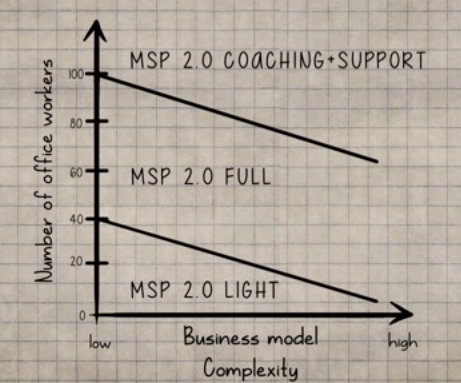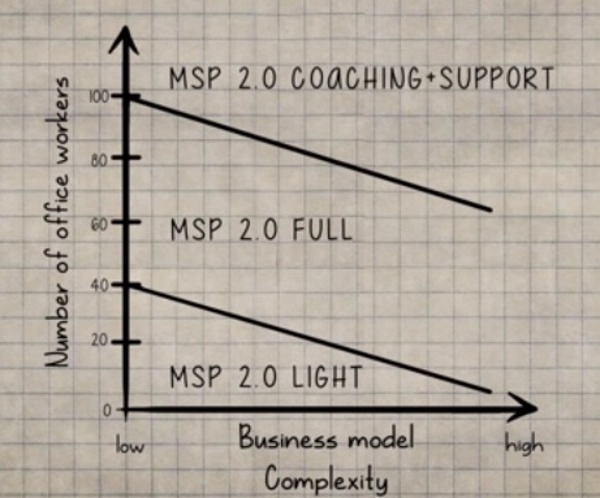

Many MSPs are not able to well define their target segments. The result can be a huge sales effort with disappointing sales closes. There are three main differentiating factors we could use to fine tune service directed toward the different segments:
- Industry, verticality
- Seats
- Complexity
IT managed services providers could divide their market among three segments described below to benefit from more focused communication and delivery strategies.
The 3 minute video discusses the segmentation based on seats and complexity.
So you are convinced that the MSP 2.0 model with the 7C is a good companion for you. Maybe you are just interested in who can benefit from such services; who are the target markets? So here’s a nice chart again. We are going to see how we can divide the market into meaningful segments to be able to communicate better and give the needed service.
In this chart the horizontal axis shows the business model complexity, with respect to the operation and the business processes of the client. You know clients whose processes are fairly straightforward and easy to maintain, but you also know clients who are developing the internal operation building systems all the time. So we measure these activities on the scale of the horizontal axis.
On the vertical axis there is basically the size of the company with relation the IT ecosystem. So if there is a manufacturing plant with 40 office workers and 150 floor workers, we count them as 40. If there is a service company with 20 employees with individual subcontractors of 20, all of them connected in any way, we count it as 40 as well. We want to see the people involved in the IT ecosystem.
Let's divide this chart into 3 segments.
The first segment is the MSP 2.0 light segment
Here we have the companies with fairly low need for IT management and MSP 2.0 services.
Either they have 30-40 people, but very limited complexity, or very few people with a complex operation, but they can handle it mostly themselves.
We can offer them an MSP 2.0 light version, which includes only the yearly cycles with IT strategy facilitation, budget settings, alignment, and the quarterly sessions with action plans etc.
We are just trusted advisors here, giving them the structure, and the facilitation. The rest they can do, of course with our management support from the background.
The second segment contains the companies with more people and more complexity
The upper limit is where they have to have an internal CIO full time with an internal IT team. This is flexible depending on the industry and the management style.
So in this middle segment, we can run our weekly and monthly IT management rhythms. In this section we are involved more in the execution part of the operation and are leading the departments and so on.
This is the ideal way to deliver the MSP 2.0 as we have full control and we can give the best value per dollar.
In the third segment are the companies with internal CIO, part time CIO, and internal IT
Here our value is in providing the necessary framework for them for an efficient operation. Basically we can onboard them to the MSP 2.0 activities, coach, support them and give additional management capacity, outside control and advice.
This is a very fruitful segment, because we are able to get a very limited accountability in general, but we can get a project to manage or execute completely. So this is a good way to have a strong link with a company who usually runs several high value projects all the time.
So the lines are not strict but more like guidelines. You have to put your clients in one of these slots, and try to establish the model as best suits their needs. In the first segment you have limited resources but high profitability, in the second the monthly recurring is highest and you can get decent project work and additional management work as well. In the third you are the trusted advisor and help them establish their efficient IT operation, and you can get the juicy projects to manage or execute.



